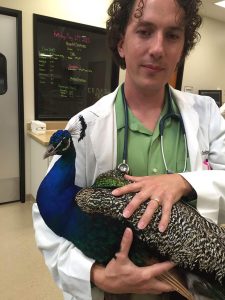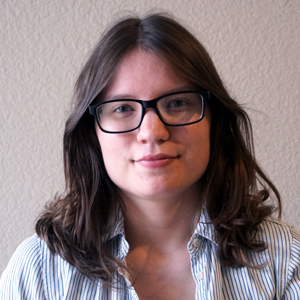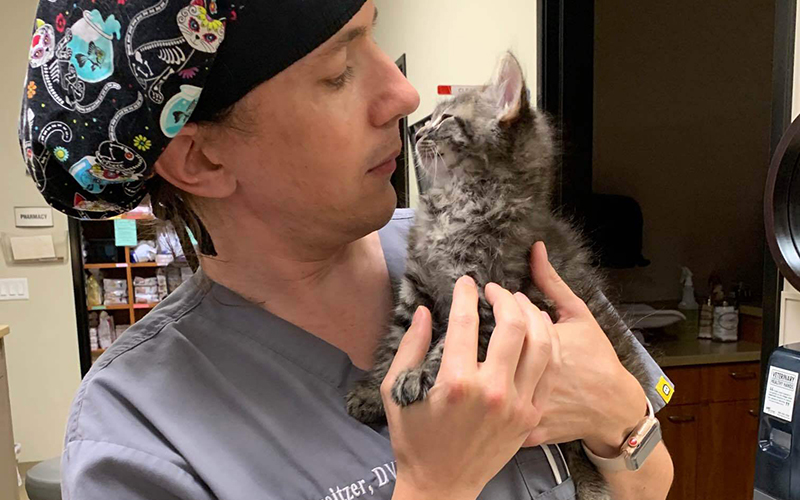In 2014, veterinarian Jason Sweitzer started his 10-minute drive home from the clinic in Conejo Valley, California, where he routinely treated animals that had been stabbed, shot, abused and made to suffer other horrors.
This time, his thoughts drifted to suicide.
“No one else was on the road. What if my car just veered off the highway?” Sweitzer recently recalled, his voice wavering.
Although he was alone that night, hundreds of other veterinarians have traveled the same path as Sweitzer. Many veterinarians face a mountain of debt after medical school and struggle to cope with the trauma endured by pets, the emotional distress and stressful social interactions in a line of work where the patient can’t speak, and pet owners facing life and death decisions.
Veterinarians are 2.7 times more likely than the general public to die by suicide, according to a 2020 study from Merck Animal Health in partnership with the American Veterinary Medical Association. Female veterinarians have higher levels of suicidal thoughts, but male veterinarians have a higher rate of suicide attempts, the study found.
Shortly after Sweitzer’s scare, he became a founding board member of Not One More Vet, an organization working to help prevent veterinarian suicide. It was founded after California veterinarian Sophia Yin died by suicide in September 2014 at age 48. She served on the executive board for the American Veterinary Society of Animal Behavior and was an award-winning columnist for the San Francisco Chronicle.
“I had to ask myself, well, if she could be lost to suicide, what’s to stop all the rest of us, all of those who aren’t as successful?” Sweitzer recalled.
Jordan benShea, the executive director of the VIN Foundation, has seen some of the struggles veterinarians share with the network firsthand.
“I think the two most challenging factors in the veterinary profession right now are mental health and student debt, and they play off each other,” benShea said.
The VIN Foundation’s student debt center includes a map that lists general costs for all veterinarian schools within the U.S., the U.K., Australia and the Caribbean. Of the 52 colleges listed, University of California, Davis is the ninth most expensive, with an average cost of $265,309. The most expensive U.S. school is the Midwestern University College of Veterinary Medicine in Glendale, Arizona, where the average cost is $421,137.
Medical schools of any kind come with steep prices, but one factor makes it more difficult for those in animal medicine to climb out of debt: Veterinarians face that debt while making about half what doctors in human medicine earn.
According to the federal Bureau of Labor Statistics, the average salary of a veterinarian in California in 2019 was $116,440, while surgeons and physicians in the state on average made $208,740 annually. Nationally, veterinarians make an average of $104,820 annually; in Arizona the average is $107,700.
Mental health concerns have led to support groups like VIN Foundation’s Vet4Vet organization, a counseling program offering worldwide confidential peer support for veterinarians.
Under the skin
Paul Pion – DVM, DACVIM, a board certified veterinarian and a founder of the Veterinary Information Network – distinctly remembers his internship at the Animal Medical Center in New York City in 1983. Some nights he was the only veterinarian on duty from midnight to 8 a.m.
“I was walking out into the waiting room at 2 a.m. and standing there saying, ‘OK, who’s bleeding more?’” he said.

Not all of California veterinarian Jason Sweitzer’s patients are cats and dogs. (Photo courtesy of Jason Sweitzer)
It was traumatic for a new graduate. There were days after rough shifts when Pion went windsurfing and almost didn’t turn back to shore.
“I didn’t want to go back that night,” he said.
Other board members could testify to the hard days on the job as well. Many of the accounts led back to one memory: euthanasia.
Sweitzer graduated in 2009 from the prestigious UC Davis Veterinary School, where, in one of his clinics, the colored dye of the euthaniasia drugs was changed frequently so it wouldn’t be as traumatic for the veterinarians. UC Davis’ VetMed department has its own counseling services to serve student needs, and coordinator Dr. Zachary Ward told Cronkite News his schedule is booked with appointments and meetings to help support students.
During his time with the VetMed department, Ward has heard students share their anxiety, fear and grievances. A major concern he has is the trauma of putting down animals on a sometimes daily basis.
Common responses to an animal being put down include relief that they “aren’t in pain anymore” or they’re “in a better place.” Such comments can begin to bleed into veterinarian philosophy, Ward said.
“Veterinarians have much greater access to the means that they would use to end their life, and are quite literally been trained on how to euthanize another living thing,” he said. “They’ve really come to understand that euthanasia can be a viable treatment plan for suffering and it can be a natural next step for them to think that it could be a viable treatment plan for their own suffering.”
There is one more facet of veterinarianism that blindsides students and early vets, benShea said.
“The other aspect of it is a lot of veterinarians get into the veterinary profession because they love animals,” she said. “But you’re dealing with people, because animals don’t talk.”
A common misconception between veterinarians and clients is how expensive animal medicine is. More than 70% of respondents claimed that scathing reviews and customer’s unwillingness to pay for animal health care were a major concern in the veterinary field, according to the 2019 survey done by Merck Animal Health. What many owners don’t realize, benShea said, is that some of their pet’s medical bills are significantly high because pet owners lack health insurance.
According to a 2020 research report from IBISWorld, as little as 3% of companion animals in the United States are insured. Additionally, a survey conducted by LendEDU stated that those without insurance had an average expense of $1,458 annually on their pet’s medical expenses. The dissonance between the need to fund veterinarian clinics and the public’s reluctance to pay for costly care affects veterinarians, benShea said.
The road ahead
After Sweitzer made it home the night he contemplated suicide, the house was dark and his family already was asleep. He was relieved.
“I did what any person these days will go ahead and do in an unhealthy way: I went ahead and shared it on Facebook.”
The morning after, he woke up to a stream of messages, many of which blindsided him. Notifications pinged as people reached out not to ask whether he was OK but why he would write such a thing, and how he needed to take it down before he lost his credibility as a veterinarian. It opened his eyes to the stigma around suicide and mental health in his field, and how much needed to be done.
Sweitzer also received many messages from people who thanked him for sharing his struggles and let him know he was not alone.
“I had no idea that some of these family members, friends, colleagues, were struggling anywhere near what they were,” he said. “And just by accident or sharing what my struggles brought so many people out that were in my close circles. It really, really, truly hit home for me that this is a very widespread problem.”
Around the country, the demand for mental health assistance in the veterinary field is high. UC Davis’ VetMED counseling program is expanding, the VIN Foundation receives emails from veterinarians asking for help and Not One More Vet has grown to more than 20,000 members in six years.
Since his suicide ideation, Sweitzer has relocated to a new veterinarian clinic, one where mental health is emphasized greatly. Despite his perfectionism, he is forced to be human, which is a challenge for him. Since he opened his eyes to his own suffering and the suffering of those around him, his future has taken him down a different road – one that’s far less lonely.


